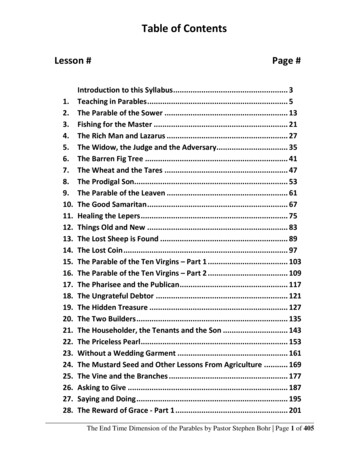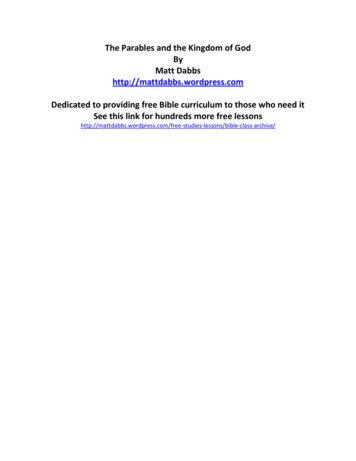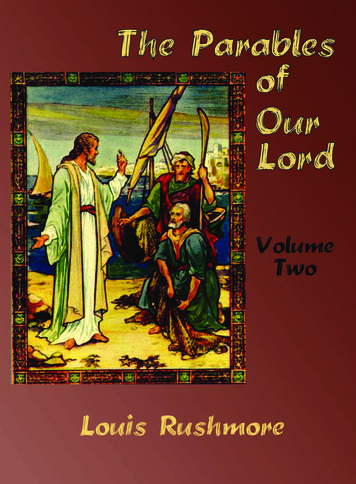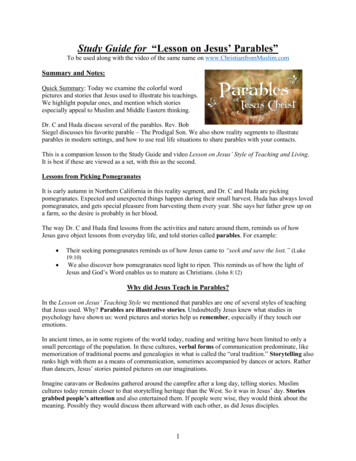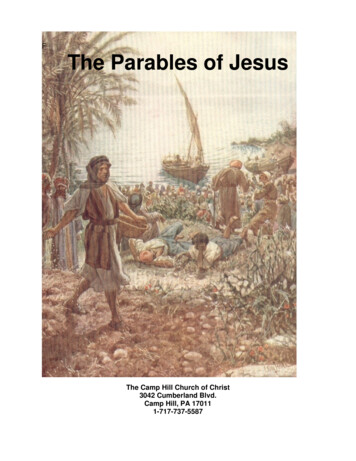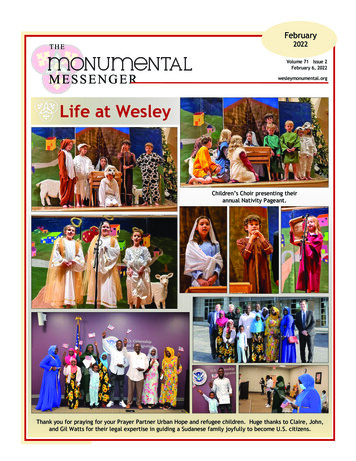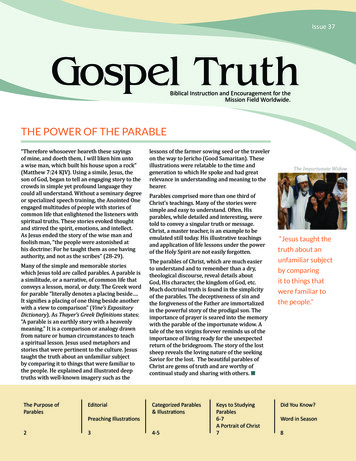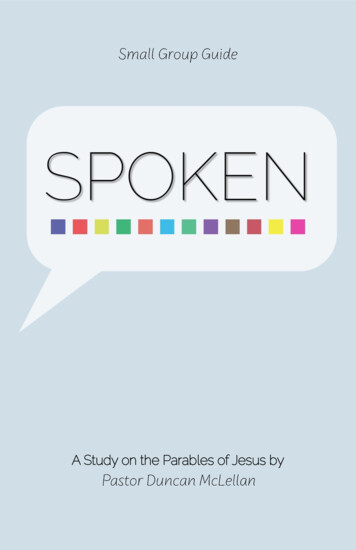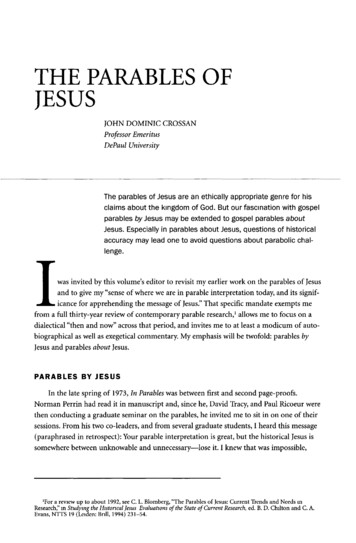
Transcription
THE PARABLES OFJESUSJOHN DOMINIC CROSSANProfessor EmeritusDePaul UniversityThe parables of Jesus are an ethically appropriate genre for hisclaims about the kingdom of God. But our fascination with gospelparables by Jesus may be extended to gospel parables aboutJesus. Especially in parables about Jesus, questions of historicalaccuracy may lead one to avoid questions about parabolic chal lenge.Iwas invited by this volume's editor to revisit my earlier work on the parables of Jesusand to give my "sense of where we are in parable interpretation today, and its signif icance for apprehending the message of Jesus." That specific mandate exempts mefrom a full thirty-year review of contemporary parable research,1 allows me to focus on adialectical "then and now" across that period, and invites me to at least a modicum of auto biographical as well as exegetical commentary. My emphasis will be twofold: parables byJesus and parables about Jesus.PARABLES BY JESUSIn the late spring of 1973, In Parables was between first and second page-proofs.Norman Perrin had read it in manuscript and, since he, David Tracy, and Paul Ricoeur werethen conducting a graduate seminar on the parables, he invited me to sit in on one of theirsessions. From his two co-leaders, and from several graduate students, I heard this message(paraphrased in retrospect): Your parable interpretation is great, but the historical Jesus issomewhere between unknowable and unnecessary—lose it. I knew that was impossible,*For a review up to about 1992, see C. L. Blomberg, "The Parables of Jesus: Current Trends and Needs inResearch," in Studying the Historical Jesus Evaluations of the State of Current Research, ed. Β. D. Chilton and C. A.Evans, NTTS 19 (Leiden: Brill, 1994) 231-54.
248InterpretationJULY 2002since I was discussing reconstructed parables, parables reconstituted as plot summariesfrom their present gospel locations and interpretations I was trying to analyze the parablesof the historical Jesus, not those of Matthew, Mark, Luke, or Thomas The seminar's reac tion prompted me to add these phrases to the preface in order to have it both ways "Theterm 'historical Jesus' really means the language of Jesus and most especially the parablesthemselves," and "One might almost consider the term 'Jesus' as a cipher for the reconstruct ed parabolic complex itself"2 Yet the book's subtitle was and would remain "The Challengeof the Historical Jesus " It has been clear to me from the beginning that my interest was inparable because of Jesus, not in Jesus because of parable And, of course, almost thirty yearslater The Historical Jesus was subtitled not The Language of a Mediterranean Jewish Peasantbut The Life of a Mediterranean Jewish Peasant That was also a deliberate choice What wasat stake for me in that development?First of all, why focus on parables as the challenge of the historical Jesus? Why not onhealings or exorcisms, dialogues or debates, actions or incidents? What justified givingparables that priority or privilege?I was still working with the general scholarly presupposition that the criterion of dis similarity was the most valid basis for reconstructing Jesus, and I summarized its use as fol lowsSince creative reinterpretation by the primitive church is the presupposition of the whole problem, a rigorous negativity must be invoked to separate what Jesus said or did from what the tradition records of his words and deeds One must look especially for divergence between this earliest form and the general attitude of the primitive church Only when such can be discerned canone be methodologically sure that it stems from the historical Jesus and not from the creativityof the church This will be all the more secure when the original saying has been reinterpretedback toward Judaism in the usage of the earliest Jewish Christianity itself In such cases one cansee the radicality of Jesus being muted back into normalcy3But to that general methodological presupposition, I added the nuance that the criteri on of dissimilarity "will apply not only to subject and content but even more especially tostyle and to form One is especially interested in forms of expression which are peculiar to4Jesus and with which the primitive church does not seem to be too much at home " Inother words, the parables were the most securely original material m the Jesus traditionbecause of the application of the dissimilarity principle to "the form as well as the contentof Jesus' words," that is, "to Jesus' use of metaphor in sustained parabolic form " Those nar rative parables seemed to be most surely his own characteristic pedagogic genre as "distinct5from the usage of the primitive church and also contemporary Judaism " Not that parablesmade Jesus' religious pedagogy superior to other options from that intertwined back-2J D Crossan, In Parables The Challenge of the Historical Jesus (New York Harper & Row, 1973, reprintedSonoma, Cal Polebridge, 1992) See ρ xiii (original) or ρ vu (reprint)3Ibid , 54Ibid5Ibid, 7
PARABLESInterpretation 249ground; rather, they are simply distinctive enough to be recognizable and therefore separa ble from it. Such distinctiveness, of course, might well entail a different function or pur pose.Norman Perrin claimed that when we "ask ourselves the question as to whether this[earliest form of a given] saying should now be attributed to the early Church or to the his torical Jesus . .the nature of the synoptic tradition is such that the burden of proof will beupon the claim of authenticity Γβ In his detailed literary-social study of the parables BernardBrandon Scott disagreed, at least for that parabolic genre. For parables, "the burden ofproof [falls] on the one who would claim that the originating structure of a parable is notfrom Jesus."7 He gives three reasons for "reversing the burden of proof." The parabolic genreis (1) absent in the Hebrew Bible and Hellenistic literature, (2) lacking in the pre-70 C.E.traditions of the Pharisees, and (3) rare in early Christian traditions. "Only the SynopticGospels, Q, the Gospel of Thomas, and the Apocryphon of James contain parables. Outsidethese texts no parables occur." He concludes that those "three observations do not prove theauthenticity of Jesus' parables—that all the parables go back to Jesus. Rather, they shift theburden of proof to those who would argue that a parable or its originating structure is notfrom Jesus."8Four points, two of agreement, two of possible disagreement. First, I agree with Scotton what he terms the "burden of proof." Although he does not mention the criterion of dis similarity or its application to parabolic genre or form, he has strengthened the case for myown initial approach to the parables.9 Second, I also agree on what Scott calls the "originat ing structure" and I had termed ipsissima structura to deny the possibility of ipsissimaverba.10 Jesus may, of course, have told the same parable on many different occasions buteven or especially in such oral situations, the same rather than a different parable requires arecognition of structural similarity rather than verbatim sequence, just as you recognize thesame joke as distinct from a different one on the same subject. There are, for example,many ways of telling the parable of the helping Samaritan, but a story about the helpedSamaritan is not one of them.Third, our gospel parables are but plot summaries of any such performance matrix.The Good Samaritan parable, for example, takes a minute to read and, in an oral situation,a sneeze would have obliterated the key word and the parable lost its whole challenge. Inactuality, it must have taken much longer—with more detail and more acting—to tell it toan audience. An hour, maybe? I presume Jesus, like any oral speaker or teacher, was able to6N Perrin, Rediscovering the Teaching of Jesus, NTL (London SCM, 1967) 39, emphasis originalB Β Scott, Hear Then the Parable A Commentary on the Parables of Jesus (Minneapolis Fortress, 1989) 63Ibid, 63-649J D Crossan, The Dark Interval Towards a Theology of Story (Niles, 111 Argus, 1975, reprinted Sonoma, CalPolebridge, 1988), idem, Raid on the Articulate Comic Eschatology in Jesus and Borges (New York Harper & Row,1976), idem, Finding Is the First Act Trove Folktales and Jesus' Treasure Parable, Semeia Supplements 9 (Missoula,Mont Scholars Press, Philadelphia Fortress, 1979), idem, Cliffs of Fall Paradox and Polyvalence in the Parables ofJesus (New York Seabury, 1980)10Crossan, Cliffs of Fall, 2778
250InterpretationJULY 2 0 0 2expand or contract a given parable to fill the time available at any specific time and placeFourth, from the beginning I emphasized a thrust withm Jesus' total parabolic complextoward "action"—but an action that was as unspecified in content as it was urgent indemandnI also emphasized a clash between "the structure of speaker expression" and "thestructure of hearer expectation" as well as the presence of paradox and polyvalence in Jesus'parables12At that point, I could go no further because I was working only with parables asmaterial and using only literary criticism as method In the 1980s, therefore, I widened mymaterial for historical Jesus research from parables to aphorisms and from words to deedsMy method shifted from an emphasis on double dissimilarity in tradition to multiple independence m attestation and broadened to create an interactive and interdisciplinary matrixof cross-cultural anthropology, Judeo-Roman history, and Galilean archaeology, as well asliterary criticism13By the early 1990s, even after The Historical Jesus, I still could not seehow Jesus' context made Jesus' parables especially appropriate as a pedagogical strategy forthe kingdom of GodI first saw that clearly, and maybe too slowly, after reading William R Herzog's analysisof Paulo Freire's pedagogy of the oppressed m Brazil and Chile "It may seem odd," Herzogcomments, "that a literacy program could generate a revolutionary pedagogy Yet it did sobecause Freiré used the vocabulary of the poor as a tool of social analysis so that, as theywere learning to read, they were simultaneously learning to read their culture, including itssystems of domination, exploitation, and marginahzation" 1 4 When Jesus' parables of theKingdom are read on that analogy, they are not seen asprimarily a vehicle to communicate theology or ethics but [as] a codification designed to stimulate social analysis and to expose the contradictions between the actual situation of its hearersand the Torah of God's justiceMatters of justice were not peripheral to a spiritual gospel butwere at the heart of his proclamation and practice Perhaps it would be more accurate to say thatjustice was at the center of Jesus' spirituality It is a conceit of the North American church thatJesus was not involved in politics and economics but limited himself to spiritual matters 15The pedagogical ethic of a Jesus or a Freiré intends a generative and transformativeraising of consciousness so that "mystified illiterates became critical-thinking readers oftheir world" 16 That also means, of course, that the parabler has ceded control to the parabled It is they who must debate message and meaning, argue interpretation and implication, and only their silence is the parable's failureHCrossan, In Parables, 34-36The Dark Interval, 67 (reprint, ρ 51), and throughout that book Note the subtitle of Cliffs of FallSee J D Crossan, The Historical Jesus The Life of a Mediterranean Jewish Peasant (San FranciscoHarperSanFrancisco, 1991) xxvu-xxxiv, and idem, The Birth of Christianity Discovering What Happened in theYears Immediately after the Execution of Jesus (San Francisco HarperSanFrancisco, 1998) 137-235 (where methodology is much more self consciously critical) For archaeology and exegesis, see especially J D Crossan and J LReed, Excavating Jesus Beneath the Stones, Behind the Texts (San Francisco HarperSanFrancisco, 2001 (passim)14W R Herzog II, Parables as Subversive Speech Jesus as Pedagogue of the Oppressed (Louisville WestminsterJohn Knox, 1994) 2015Ibid , 28, 264 (which I have taken the liberty of combining)16Ibid, 24n13
PARABLESInterpretation 251All of that is clear m Herzog's first example, the parable of The Vineyard Laborers in17Matt 20 1-16 Standard interpretation focuses on the conclusion, on the owner's generosi ty, and on its possible modeling of a gracious God But most of the parable is about theowner going out at 6 a m , 9 a m , 1 2 noon, 3 p m , and 5 p m and always finding daylaborers waiting for work He does not have to hire all he can at dawn and pay them whatthey demand He knows that there is such high unemployment that he controls the hiringeven at harvest-time and even late in the day And, of course, he can call them lazy whenthey are not hired The parable's conclusion raises a question of individual justice is the?generosity of the owner good, bad, indifferent, or what But the parable's mam content rais es a question of systemic justice is the situation of maximum unemployment normal orabnormal, right or wrong? Jesus must trust his audience to raise those questions, to see thedifference between personal and structural justice, to debate about that difference, and towonder whether the kingdom of God was about ideal human charity or radical divine justice There is no presumption that his audience is entirely homogeneous—it could includeday-laborers, tenant farmers, small freeholders, stewards, and even some local land ownersIt would be precisely in the inevitable clash of response that any raising of consciousnesswould take place And it would take time and repetitionThere is one important footnote to that understanding of Jesus' parabolic pedagogy ofthe oppressed When modern commentators accept that parabolic function, they also loseany way to tell what would have happened in any given situation It was up to the hearers toraise their own consciousness through communal agreement and disagreement Jesus' para bles were lures not for personal thought by isolated readers but for corporate debate byinteractive hearers "It is probably impossible," as Herzog concluded on The VineyardLaborers, "to reconstruct the lively conversation that the encoded parable generated,"18 andthat impossibility holds for all the parables "At this point, the study given here faced a sig nificant difficulty It had proposed that parables were discussion-starters They were used toinvite conversation and to lure their hearers into the process of decoding and problematizing their world But there are no records of the conversations that they generated"19 But ofcourse we can at least imagine the divergent responses that individuals would shout back atthe speaker and at one another in any oral situation of that time and place Two otheranalyses published before Herzog's book may point in that same directionDouglas Oakman asked whether Jesus was a peasant, and answered affirmatively that"occupationally, Jesus is best understood as a peasant child forced to leave the village insearch of livelihood " 2 0 If Jesus was a peasant speaking to peasants, would they have consid ered the Samaritan as good or as foolish (Luke 10 30-35)? "Jewish peasants would havemultiple reasons for not being sympathetic For them, the Samaritan is a cultural enemy, an17Ibid 79-95Ibid 95Ibid 26120D E Oakman Was Jesus a Peasant? Implications for Reading the Samaritan Story (Luke 10 30-35) BTB 22(1992) 117-25 The quotation is from ρ 1201819
252 InterpretationJULY 2 0 0 2evil man, and a fool: An enemy because a Samaritan, evil because a trader, a fool because hetreats a stranger like family and is unsawy about the situation at the innWould not peasants21have laughed all the way through Jesus' story?" Finally, he asked, "was the story originallyintended to function in a social-critical fashion?" Linking parables and kingdom of God, hereplied that "the Kingdom represents social challenge and transformation."22Of course, Jesus' audience(s) would not have been homogeneous in class, and even thepeasantry would hardly all have agreed about the Samaritan—especially if they imaginedthemselves in that ditch. It is not a case of replacing the monovalent "good" with an equallymonovalent but opposite "foolish" protagonist. Rather, all such judgments—about goodand bad, about clergy and laity, about Jew and Samaritan, about traders, bandits, andinns—would have been argued out between speaker and audience and within the audienceas well. It is precisely in that interactive debate that social consciousness could be raised,transformation could be activated, and the kingdom of God could be entered. And, in nondominating pedagogy, could be is more than enough.Richard Rohrbaugh asked a similar question about "a peasant reading of the parable ofthe talents/pounds." In the peasant world of imposed limitation, with its ethic of familysubsistence and village security rather than imperial exploitation and commercial wealth,one experienced rich people as "inherently evil. because to have gained, to have accumulated more than one started with, is to have taken the share of someone else."23 In that peasant morality, the first two servants would be exploiters who probably increased the master'smoney by loans and foreclosures (of peasant farms), and it would be the third servant whoacted honorably and ethically by refusing to enter into such oppressive activity. Rohrbaughalso noted that when Eusebius recorded the version of this parable from the Gospel of theNazoreans, he described the three servants as having respectively squandered, multiplied,and hidden their master's money, so that they received, respectively, prison, rebuke, andacceptance. In other words, that extracanonical version and the comments of Eusebiusjudge that multiplying the deposit is reason not for praise but for rebuke.Rohrbaugh commented that "the Nazorean rendition fits the environment of Jesusmuch more easily than either of the canonical versions of the story" so that "the presentscholarly judgment about the secondary character of the Nazorean text. surelywarrant [s] a new and closer look."24 Be that as it may, there is still an unresolved tensionbetween a monovalent reading of the parable—even if it changes the approval from multiplier to hider—and a polyvalent reading that presumes audience debate precisely aboutwhere approval should fall. Rohrbaugh concluded that "Jesus' peasant hearers would almostcertainly have assumed [the parable] was a warning to the rich about their exploitation of21Ibid., 123.Ibid., 123-24.R. L. Rohrbaugh, "A Peasant Reading of the Parable of the Talents/Pounds: A Text of Terror?" BTB 23 (1993)32-39. The quotation is from p. 34.24Ibid., 37.2223
PARABLESInterpretation 253the weak. Is it possible that they were right?"25 But Rohrbaugh reasoned that Jesus' audienceincluded not just peasants but others as well. That is surely correct. Even if Jesus' audiencewas composed primarily of peasants, it would not have been exclusively so. And evenamong peasants, there would be diversity of outlook, as Antipas's romanization, urbanization, commercialization, monetization, and scribalization changed Galilean peasant lifepatterns. If an audience contained others as well as peasants and if "the elitist reading is badnews for peasants" while "the peasant reading is bad news for masters" (38), would notaudience debate have been inevitable—and also intentional on Jesus' part?Robert T. Fortna described a debate among maximum security prisoners who had chosen the parable of the Talents for their theological discussion group.26 Asked "which ofthose three slaves in the story do you like the best?," one Smitty replied, "I kinda dig thatthird dude." Asked "how do you feel about the boss?," he said, "He just part of the System.He tryin' to use me to make his money for him." My own general experience teaching parables to large classes of undergraduates is similar. You could always trust debate and disagreement—especially when somebody was quite sure what it meant. As long as the groupwas not uniformly churched, that would almost always work. Whether dealing with peasants then or now—or prisoners, or undergraduates, or anyone else—such debates wouldalmost always happen, as long as the group had not been programmed to some univocalmeaning by teaching or preaching.In summary, this is where we have arrived today: the function of Jesus' parables aboutthe kingdom of God was to create debate about justice, to raise consciousness aboutoppression, to ask how God would run this world if God sat on Caesar's throne, and to doall that through internal transformation rather than external domination. Parables were theethical mode of e-ducation upward rather than in-doctrination downward. They lured theaudience into self-education. And education is, first, foremost, and always, about knowingyour options. Parables were the special pedagogy of Jesus' kingdom of God.PARABLES ABOUT JESUSIf the preceding analysis is correct, commentary on the parables must become commentary on their diverse audiences—peasants, stewards, and masters, to be sure, but also(within the peasantry) small freeholders, tenant farmers, day laborers, beggars, and bandits.But also, and above all, it will be about the twenties CE. in Lower Galilee, when the dislocating effects of romanization-as-urbanization finally hit full force with Sepphoris as capital in4 B.C.E. and Tiberias as its replacement in 19 CE. Future commentary will be less about theself-expression of the parabler than about the self-education of the parabled. That may be25Ibid., 38.R. T. Fortna, "Reading Jesus' Parable of the Talents Through Underclass Eyes: Matt 25:14-30," Forum 8 (1992)211-28. (Actual publication was in 1995, so Fortna could cite both Rohrbaugh [1993] and Herzog [1994].)26
254InterpretationJULY 2 0 0 2the future for the parables of Jesus but what about parables about Jesus? Maybe that iswhere we will have to stretch our imaginations even more fully.I still agree with Scott's conclusion that the earliest Christian tradition did not inventmany parables and place them on the lips of Jesus, that "the tradition was not as creative inregard to parables as it was with other elements of the Jesus tradition."27 Why? I suggest thatthe tradition did not spend much time creating parables by Jesus because it was too busy creating parables about Jesus. I begin, as in the previous section, with autobiography.In June 1967 I returned to the States from a sabbatical at Jerusalem's Ecole Biblique.During the next two academic years I taught graduate courses on the resurrection texts andon the parables. There were no curricular demands for those subjects so I must have chosenthem freely, but I no longer remember why—except, of course, that they interested meenough to study them, teach them, and think about them. I do not recall choosing them asconjunctive or comparative data, but I did notice that the ways in which the evangelists toldand retold, adopted and adapted the parabolic stories by Jesus seemed remarkably similar tothe way they told and retold, adopted and adapted the resurrection stories about Jesus.At that time, and especially in lectures to laity about biblical historicity, I used the following, again and again, as a fundamental example. It is still such for me. Luke tells theinaugural revelation of the Risen Lord to Paul three times in the Acts and he must haveknown you would get eventually from Acts 9 through Acts 22 to Acts 26, and you mighteven compare those divergent versions. Apart from other minor differences he consideredunimportant, Luke carefully worked the central revelation of Paul's pagan-mission mandateso that, first, it came from God to Ananias in 9:15-17, then from Ananias to Paul in22:12-15, and, climactically, from God directly to Paul in 26:14-18. That self-conscious andquite deliberate Lukan process served as a fundamental case-study from which I couldexplain creative redactions of either parable or resurrection stories. In other words, the creative handling of resurrection stories—especially that constitutive case—was influencingmy understanding of parable stories rather than vice versa.In the later 1960s, then, I could have pursued research and publication in either direction, toward parable or toward resurrection. From that beginning over thirty years ago, Isaw at least those resurrection stories as parables about Jesus, as utterly self-conscious creations by writers who knew exactly what they were doing. I would say eventually aboutLuke 24:13-35 that "the symbolism is obvious as is the metaphoric condensation of the firstyears of Christian thought and practice into one parabolic afternoon. Emmaus never happened. Emmaus always happens."28 As it happened, however, I proceeded to concentrate onparable stories and not resurrection stories. But what I propose here is that we start to concentrate at least equally on parables about Jesus as we have always done on parables by7Scott, Hear Then the Parable, 64.'Crossan, The Historical Jesus, xni. By the way, Emmaus is still inaugurally there in The Birth of Christianity, xi.
PARABLESInterpretation 255Jesus. Here are two examples of how that might workA first and rather simple case. The Epistula Apostolorum 5 lists the miracles of Jesus andamong them that "he walked on the sea, and the winds blew, and he rebuked them, and thewaves of the sea became calm."29 Despite that combination of Mark 4:35-41 and 6:45-51, itis not much of a story, and "walking on the sea" allows for little response, perhaps, beyond"Jesus is as divine as Poseidon'" or, more wisely, "how very nice for Jesus'" But what if oneread the whole story in Mark 6:45-51, read it as a deliberately and self-consciously createdparable? Jesus sends out the disciples without him They get nowhere He walks on the sea, out,as it were, for a pre-dawn stroll He does not help them until they cry out Then he enters theboat and all is well The walking on the sea is not a self-indulgent short-cut homeward noran act of assistance to an endangered fishing-fleet. It is much more precise than that: thedisciples (the church or the leadership of the church?) make no progress without Jesus intheir boat, must acknowledge that, and ask him in. We could, of course, argue about his toricity, and that may be the safest way to avoid the story as deliberate parable. For, if it is aparable, it asks us to debate among ourselves what happens to a church without Jesus.Furthermore, is it not fascinating that somebody already asked that question long beforethe first century was over?A second and more complicated case. I begin again with this summary statement fromthe Epistula Apostolorum 5: "Then when we had no bread except five loaves and two fish, hecommanded the people to he down, and their number amounted to 5000 besides womenand children, whom we served with pieces of bread; and they were filled, and there were(some) left over, and we carried away twelve baskets full of pieces." That, at least, is more asummary story than a summary statement, and it distinguishes a "he" and a "we."30 Onceagain, however, one should read the entire narrative, the whole story in Mark 6:34-44. Inthis case, I also compare that version with the one in John 6:5-13.For convenience, I have divided the story into five moments and named them Solving,Seeking, Seating, Distributing, and Gathering. Also, I have emphasized the dialectic of heand they because in this miracle there is an unusual rhythm of Jesus (he) to disciples (they)and then to crowds. In this particular story, the disciples are always in the middle, arealways present not just as background but as intermediaries.29New Testament Apocrypha, ed W Schneemelcher and R McL Wilson, 2 vols (Louisville Westminster JohnKnox, 1991-92) 1 25330In most early Christian miracle lists, the interaction of Jesus, disciples, and crowd disappears completely Forexample, "in a desert place he will satisfy five thousand from five loaves and a fish of the sea, and the leftovers ofthese will fill twelve baskets for the hope of the peoples" (Sibylline Oracles 1 356-59), "from one wallet men willhave a surfeit of bread" (Sibylline Oracles 6 15), "from five loaves and a fish of the sea he will satisfy five thousandmen in the desert, and taking all the leftover fragments, he will fill twelve baskets for the hope of the peoples"(Sibylline Oracles 6 275-78) See The Old Testament Pseudepigrapha, ed J H Charlesworth, 2 vols (Garden City,Ν Y Doubleday, 1983-85) 1 343, 407, 424
256 InterpretationJULY 2 0 0 2Solving (Mark 6:35-37; John 6 5-7). In Mark the situation of hunger begets two divergent solutions. For the disciples, who speak first and bring up the problem, it is: "send themaway." For Jesus, it is: "you give them something to eat." They find the directive silly and sayso bluntly. Those divergent solutions mean that Jesus pulls the disciples into the middle ofeach succeeding step. They are forced to follow Jesus' solution. John is quite different onthis first element and so also thereafter.When it grew late, his disciples came to him andWhen he looked up and saw a large crowd comingsaid,toward him, Jesus said to Philip,THEY "This is a deserted place, and the hour isnow very late, send them away so that they may gointo the surrounding country and villages and buysomething for themselves to eat "HEBut he answered them, "You give themsomething to eat "HE"Where are we to buy bread for these peopleto eat?" He said this to test him, for he himselfknew what he was going to doTHEY They said to him, "Are we to go and buyTHEY Philip answered him, "Six months' wagestwo hundred denarii worth of bread, and give it towould not buy enough bread for each of them tothem to eat?"get a little "Seeking (Mark 6.38; John 6 8-9). In Mark, then, but not m John, the dialectic of Jesusand disciples continues. They are sent to find out what food is available and then reporttheir findings.H
*For a review up to about 1992, see C. L. Blomberg, "The Parables of Jesus: Current Trends and Needs in Research," in Studying the Historical Jesus Evaluations of the State of Current Research, ed.Β . D. Chilton
